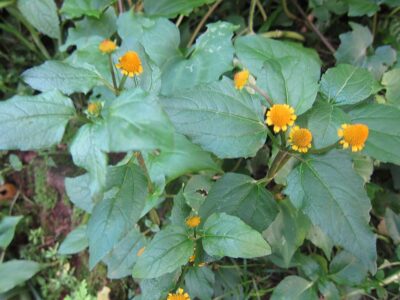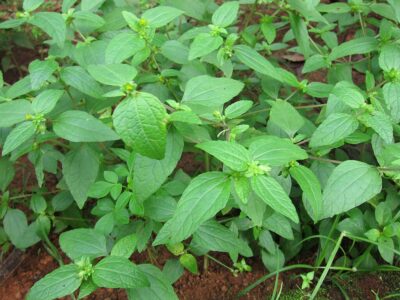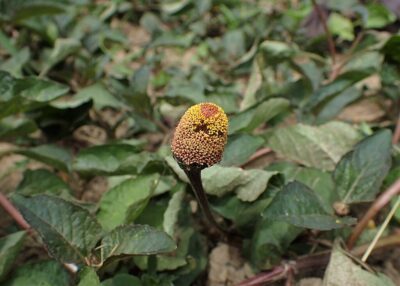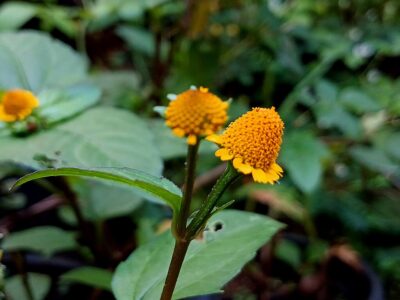
Toothache plant
കാക്കര, CC BY-SA 3.0, via Wikimedia Commons
Acmella oleracea, commonly known as toothache plant or electric daisy, is a flowering herb native to South America. It is best known for its yellow, button-like flowers that produce a strong tingling or numbing sensation when eaten. Traditionally used to relieve tooth pain, it is also consumed in salads, teas, and herbal remedies. The plant contains spilanthol, a bioactive compound with medicinal and culinary interest.
Names
Scientific
Acmella oleracea
Synonym
Spilanthes acmella
Spilanthes oleracea
English
Buzz buttons
Electric daisy
Jambu
Paracress
Spilanthes
Szechuan buttons
Tingflowers
Toothache plant
Dutch
Abc-kruid
Champagneblad
Parakers
Spanish
Hierba de los dientes
Paracress
French
Brèdes mafane
Cresson de Para
German
Jambú
Parákresse
Taxonomy
Order
Asterales
Family
Asteraceae
Genus
Acmella
Species
Acmella oleracea (Toothache plant)
Basic information and facts
Origin:
Toothache plant is native to tropical South America, especially Brazil and Peru, where it has long been used in traditional medicine and cooking.
Distribution:
Now cultivated in tropical and subtropical regions worldwide, including Southeast Asia, Africa, and parts of North America and Europe.
Annual, biennial, or perennial:
Grown as an annual in most climates, but behaves as a short-lived perennial in frost-free regions.
Flowers:
Small, button-like flower heads, typically yellow with a red or brown center. Flowers are rich in spilanthol, the compound responsible for the numbing effect.
Leaves:
Bright green, soft, and ovate with slightly toothed margins. Edible and often added to salads or used as medicinal greens.
Fruits:
Small, dry, and inconspicuous fruits containing multiple seeds. The plant is not typically grown for fruit harvest.
Climate and weather:
Prefers warm, humid climates with full sun to partial shade. Sensitive to frost and cold temperatures; thrives in tropical to subtropical zones.
Pollination:
Mainly pollinated by insects, especially bees. The flowers attract a wide range of pollinators due to their color and nectar.
Height:
Typically grows 20 to 60 cm tall (8 to 24 inches), forming a low, bushy herbaceous plant.
Spacing:
Space plants 25–30 cm apart to allow for adequate air circulation and spreading growth habit.
Propagation:
Usually propagated by seed, sown directly or started in trays. Can also be propagated by cuttings in warm climates.
Insect pests:
Generally pest-resistant, but may occasionally be affected by aphids, caterpillars, or leaf miners.
Diseases:
Fungal diseases like powdery mildew or damping-off may occur in humid or poorly drained conditions. Good airflow helps prevent problems.
Harvesting:
Young leaves and flower heads can be harvested as needed. For medicinal or culinary use, flowers are picked when fully developed.
Uses:
Used traditionally for toothache relief due to its numbing effect. Also consumed in salads, teas, and herbal remedies. Gaining popularity in mixology and functional foods.
Crop categories
Leaf vegetables
Medicinal plants
Minor crops
Subtropical crops
Tropical crops
Vegetables
Pictures

Acmella oleracea
കാക്കര, CC BY-SA 3.0, via Wikimedia Commons

Acmella oleracea
Krzysztof Ziarnek, Kenraiz, CC BY-SA 4.0, via Wikimedia Commons

Toothache plant
Nativeplants garden, CC BY-SA 4.0, via Wikimedia Commons
